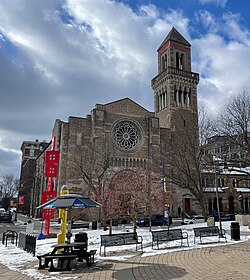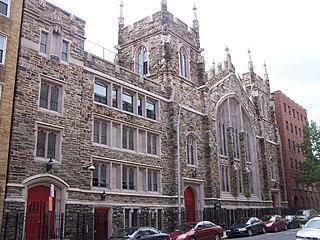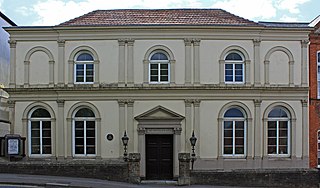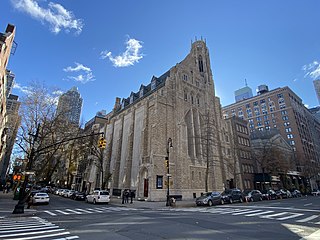The roots of Fountain Street Church date to 1824 when the region's original Baptist mission established itself to convert the Ottawa Native Americans. A lengthy history of institutional squabbles between themselves and other area Baptists eventually culminated in the two factions' reunion in 1869 to create Fountain Street Baptist Church (so named for the building they erected on the east side of downtown Grand Rapids).
Following the ministry of John L. Jackson, the church selected John Herman Randall, a young graduate of the new University of Chicago Divinity School. Over his ten-year ministry, Randall effectively converted Fountain Street Baptist Church from "traditional" to "progressive," reflecting the spirit of the Divinity School that is still known for its liberal approach to religious studies. He left to serve Mount Morris Baptist Church in New York, New York, and eventually moved on to serve John Haynes Holmes' Community Church of New York, beginning a kinship with Unitarians that continues to this day. Randall's son, John Herman Randall, Jr., became a noted philosopher at Columbia University.
While Randall's career moved the church toward a more liberal direction, his successor, Alfred Wesley Wishart—also a graduate of the Divinity School—permanently set FSC on a liberal path. Wishart's career was marked by three significant events: 1) The 1911 furniture workers' strike; 2) the rebuilding of the church following destruction by fire in 1917; and 3) the use of FSC as a public venue for international debates and lectures.
After Wishart
Wishart died in 1933 while still serving, leaving a church building with a substantial mortgage to pay off at the outset of the Great Depression. His successor, Milton McGorrill, thus endured a difficult ministry, but he was the first FSC preacher to begin broadcasting his sermons. He left after ten years to pursue a more prosperous career on the East Coast; he served both Baptist and Unitarian churches in New England.
Following his departure, Fountain Street Baptist Church found itself at its lowest ebb since 1869: The mortgage took up nearly half of the annual budget and the Great Depression made each year more challenging than the last. Weekly worship attendance was barely above 100, and it was clear that a different and daring direction had to be pursued in order for Fountain Street Church to survive.
The search committee again consulted the University of Chicago Divinity School, taking the university's recommendation to consider a young minister in Kenilworth, Illinois, named Duncan Littlefair.
Arriving in 1944 at the age of 32, Littlefair preached in a manner unprecedented in a town heretofore saturated by a strictly conservative religious culture. His personal manner was also remarkable: He was known to drive a convertible, wear a beret, and smoke cigarettes in public. Scandalous to some and a radical to others, Littlefair nevertheless saw the church grow from less than 200 in weekly attendance to over 1000 regular weekly worshippers shortly after he arrived. At its height under Littlefair's ministry, FSC reckoned over 2000 members.
Littlefair's tenure redefined the church, jettisoning the Baptist name and association, rewriting its bylaws, and restructuring its governance and management. The traditional Sunday School was remodeled on the then-new theory of character development and renamed "Character School." Youth programming at its height involved over 200 high schoolers who brought rock and roll bands as well as lecturers to the church. Many major bands of the era performed there under so-called "Fountain Club" sponsorship, including The Mothers of Invention, The Moody Blues, and Alice Cooper.
It was not until 1960 that FSC formally separated from the American Baptists and dropped its Baptist identity. Littlefair himself had by then changed his clergy affiliation to the UUA; despite his suggestions that FSC should join the denomination, he ultimately preferred that the church remain independent and non-denominational.
Littefair's high-water mark came when friend and member Philip Buchen brought him to Washington, D.C. to give advice on whether President Gerald Ford should pardon President Richard Nixon. Though he was a social liberal, Littlefair defended the action publicly despite strong feelings in the church that doing so was wrong. One lasting effect was the impact of his friend Joseph Campbell. Returning several times over the years, his theories echoed those of Littefair and deeply affected many members' own spiritual life.
Littefair retired in 1980. In 1982, the church selected David O. Rankin of the Unitarian Universalist Congregation of Atlanta to serve it, which he did for 16 years until his retirement. During that time, Rankin penned "Ten Things Commonly Believed Among Us", which continues to be widely used by the Unitarian Universalist Association as well as Fountain Street Church. Rankin was also a regular contributor to American Rabbi magazine and well known in Unitarian circles, serving major churches in San Francisco and Indianapolis prior to coming to Grand Rapids.
Duncan Littlefair, meanwhile, remained active in the congregation, helping to choose Rankin's successor, Brent Smith, who, during his brief tenure, adapted FSC to the Internet age and rebuilt the church's organ. Differences over leadership and finances led to Smith's departure less than two years after his arrival.
Littlefair died in January 2004, at the age of 91. The following fall, Fountain Street Church selected Weldon Frederick Wooden to serve as their Senior Minister. Wooden, too, was a graduate of the University of Chicago Divinity School, making Rankin the only Senior Minister not to have studied under their auspices. He also continued the tradition of senior clergy who are from or connected to Unitarian Universalism, serving 11 years at the UU Congregational Society in Brooklyn New York, following service in Texas and Massachusetts.
Wooden, in fact, shares characteristics of his predecessors. Like Wishart, he had served on the East Coast before coming to FSC. Like McGorrill, he arrived at a time of economic uncertainty in the area. Like Littlefair, he had never before served a large church. Like Rankin, he was more a writer and thinker than an organizer. Like Smith, he knew that 21st-century churches needed to adapt to advancements in technology and media.
In August 2010, the church was defaced with piles of feces at the entrances along with conservative Christian literature. The incident was not reported to the police. The church's "Peace Pole" in support of diversity had also been knocked down several times and now is anchored in concrete. [1]


















